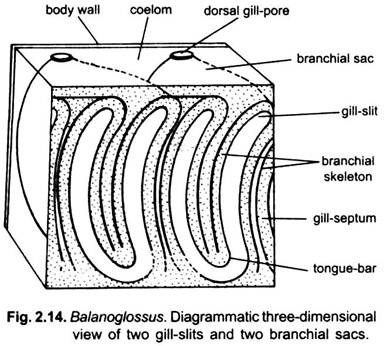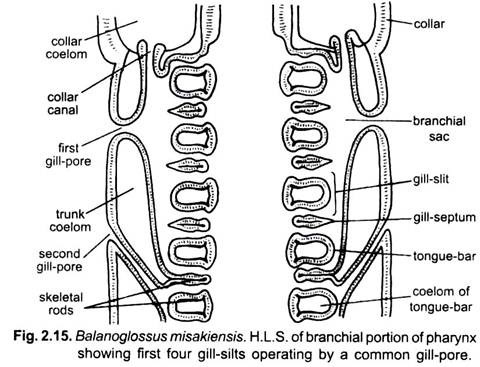In this article we will discuss about the respiratory system of the balanoglossus with the help of suitable diagrams.
Branchial Pharynx:
Two lateral longitudinal para-branchial ridges divide the pharyngeal cavity into a dorsal respiratory or branchial portion and a ventral digestive portion. Dorso-laterally, on each side, the branchial portion of pharynx is perforated by a longitudinal series of numerous U-shaped openings, the gill-slits. The number of gill-slits varies and increases as the animal grows older.
Each gill-slit is a broad oval slit in the beginning, but later, a hollow projection of dorsal pharyngeal wall, called tongue bar, grows into the slit making it U-shaped. The hollow tongue bars enclose coelomic cavity and do not touch the ventral side of the gill-slits. The portions of the pharyngeal wall between two adjacent U-shaped gill-slits are called gill-septa. The gill-septa are solid and do not enclose coelom.
A tongue bar is connected with its adjacent gill-septa by longitudinal connections are called synapticula. The tongue-bars and gill-septa are supported by M-shaped skeletal rods. The middle arm of an M-shaped rod is bifurcated at the free end and lies in a gill-septum while its outer arms lie in adjacent tongue bars. Thus, each tongue bar contains two arms of two adjacent skeletal rods. Each U-shaped gill-slit is richly lined by cilia called lateral cilia.
Branchial Sacs:
Gill-slits do not open directly to outside. Each gill-slit opens into a gill-pouch called branchial sac which lies between the body wall and the pharynx. Each branchial sac in turn opens to the exterior by a small, independent gill-pore. However, in Balanoglossus misakiensis the first four branchial sacs become united to open by a common gill-pore to outside.
The collar coelom also communicates with the common branchial sac of its side through a collar canal. The gill-pores are visible externally in two longitudinal rows, one on each side of the mid-dorsal ridge in the branchiogenital region of the trunk.
Mechanism of Respiration:
The lateral cilia lining the gill-slits create a current of water (food- cum-respiratory current) that enters the pharynx through mouth, then passes through gill-slits into the branchial sacs and finally leaves through the gill-pores. The tongue bars are richly supplied with blood capillaries and take part in respiration. The blood of their capillary networks takes up oxygen dissolved in water and diffuses carbon dioxide to it.

